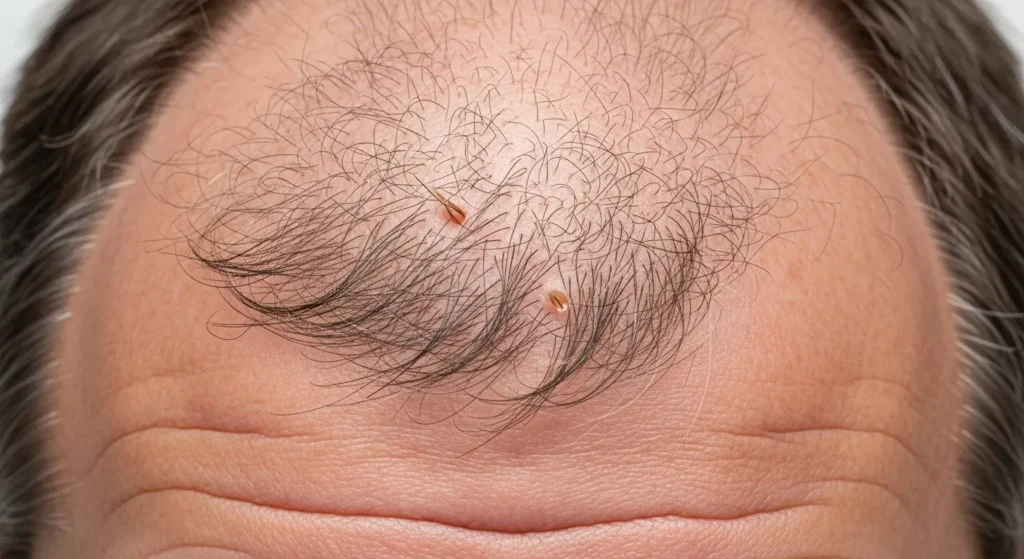If you’re experiencing thinning hair during menopause or hormonal transition, you may be wondering if the best HRT for hair loss could help. The right hormone replacement therapy (HRT) can slow shedding, encourage regrowth, and restore confidence.
In this guide, you’ll learn how different HRT types affect hair health, what medical experts recommend, and how to combine treatments for optimal results. Backed by research, specialist insights, and real patient experiences, this article empowers you to make informed, safe, and effective choices for your hair.
Understanding Hormonal Hair Loss

How Estrogen Influences the Hair Growth Cycle
Estrogen is considered a hair-friendly hormone because it prolongs the anagen (growth) phase of the hair cycle. During perimenopause and menopause, estrogen levels drop, shortening the growth phase and increasing hair shedding.
Lower estrogen can also lead to more hairs entering the telogen (resting) phase, making hair appear thinner over time.
Why Hormone Imbalance Leads to Hair Loss
When estrogen levels decline, the relative amount of androgens (like testosterone) becomes higher. These androgens can convert to dihydrotestosterone (DHT), which weakens hair follicles and leads to female pattern hair loss (FPHL).
HRT can help restore hormonal balance, reducing androgen dominance and supporting follicle health.
What Does “Best” HRT Mean for Hair?
Criteria for Evaluating HRT Options
The best HRT for hair loss should:
- Maintain stable hormone levels without large fluctuations
- Provide a form of estrogen that supports hair growth
- Include a progesterone type that does not interfere with follicles
- Minimize side effects and be tailored to the patient’s health profile
Common HRT Types & Their Impact on Hair
Transdermal Estrogen (Patches, Gels, Sprays)
Examples: Estradot, Evorel, Oestrogel, Sandrena, Lenzetto
Why it’s hair-friendly:
- Delivers estrogen steadily into the bloodstream
- Avoids liver metabolism, reducing clot risk
- Helps maintain a consistent anagen phase
Oral or Combined HRT (Estrogen + Progesterone)
- Body-identical estrogen with micronized progesterone is preferred
- Some synthetic progestins may worsen hair shedding. Expert guidance is essential
- Tablets may be convenient but carry a slightly higher clot risk than transdermal forms
Androgen-Reducing Therapies
Spironolactone
- Anti-androgen medication is often prescribed alongside HRT
- Blocks androgen receptors in hair follicles
- Especially effective for women with PCOS-related hair loss
5α-Reductase Inhibitors (Finasteride, Dutasteride)
- Reduce DHT production
- Strong evidence in men; some off-label use in postmenopausal women
- Require specialist monitoring
Antiandrogens (Flutamide, Bicalutamide)
- Positive small-scale studies for FPHL
- Used less frequently due to liver monitoring requirements
Complementary Treatments to Pair with HRT
Minoxidil (Topical or Oral)
- FDA-approved for female pattern hair loss
- Works by prolonging the growth phase and increasing follicle size
- Combining with HRT can enhance results
Low-Level Laser Therapy (LLLT)
- Non-invasive, improves scalp blood flow and cellular activity
- Can be used at home with laser caps or comb devices
Lifestyle & Nutritional Support
- Adequate protein, iron, vitamin D, and zinc
- Gentle hair care to minimize breakage
- Stress management to reduce shedding triggers
- 3 months: reduced shedding
- 6 months: visible increase in volume
- 12 months: improved hairline density

How to Choose the Right HRT for You
Checklist:
- Review personal and family medical history
- Consider delivery method (patch, gel, oral)
- Discuss hair concerns with your doctor from the start
- Ask about combining HRT with hair-specific treatments
Pro Tip: Always request hormone level testing before starting therapy.
Safety, Side Effects & When to See a Doctor
Common side effects:
- Breast tenderness
- Bloating
- Spotting
Seek immediate care if you experience:
- Leg swelling or pain
- Chest pain or shortness of breath
- Severe headaches
If hair loss worsens within 6 months, re-evaluate your treatment plan.
FAQs
Can HRT reverse menopausal hair loss?
It can slow or stop shedding and improve hair density, especially if started early.
How long until I see hair improvements?
Most women notice changes within 3–6 months, with full results after 12 months.
Are patches better than tablets for hair?
Patches may maintain steadier estrogen levels, which can be more hair-friendly.
Can HRT worsen hair loss?
If the progesterone type or dose is unsuitable, some women may experience shedding. Adjusting the regimen often helps.
Is Minoxidil safe with HRT?
Yes, and it often enhances results.
Take Your Next Step
Your hair health doesn’t have to decline with hormonal changes. The right HRT plan can protect and restore your hair safely and effectively. Book a consultation with Dr. Rana Irfan in Islamabad today to explore a personalized hormone and hair restoration program tailored to your needs.
Hair loss during menopause or hormonal transition can feel overwhelming, but targeted HRT, combined with proven hair treatment, can make a real difference.
By working with a knowledgeable specialist, you can address both the root cause and the visible effects, restoring not just your hair but also your confidence.
